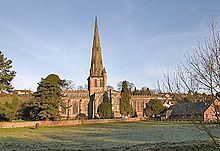Country United Kingdom Dedicated 24 April 1241 Heritage designation Listed building | Designated as world heritage site 1240 | |
Website www.ashbournechurch.org Architectural type English Gothic architecture Similar Ashbourne Hall, St John the Baptist - Tideswell, Tissington Trail, Tissington Hall, Ilam Park | ||
St Oswald's Church is a Church of England parish church located in Ashbourne, in the county of Derbyshire, England.
Contents

Background

The church is named after Oswald of Northumbria. A brass plaque in the chapel on the south side of the church commemorates its dedication on 24 April 1241 by Hugh de Pateshull, Bishop of Coventry and Lichfield.

Architecturally, it dominates the small town with its 212-foot spire which was referred to by George Eliot as the "finest single spire in England". It is said to have been started in 1240 by Bishop Hugh de Pateshull. Construction probably lasted until the early 14th century. It replaced an earlier Saxon church, and possibly a second Norman one. (A Norman crypt was discovered during excavations in 1913.)
From 1837 to 1840, it was restored by Lewis Nockalls Cottingham, and then in the 1870s by George Gilbert Scott, who added the battlements to the chancel.

Until Ashbourne Hall was partially demolished, it and St Oswald's were the town's major monuments, standing at either end of the main street. The entrance to the hall's grounds continued the main street through high gates. What remains of the hall houses the local lending library and some unrelated offices. As they were before the 18th century when the Boothby's rebuilt and refurbished their home, St Oswald's and its tower are once again the major landmark, and the church is the town's main attraction. The church is a Grade I listed building.
Stained glass

There is much stained glass in the church and these include a Christopher Whall window dated 1905. It was given to the church by Mr and Mrs Peveril Turnbull of Sandybrook Hall and it commemorates their daughters who died in a local fire. The window consists of three lights and contains representations of the Martyr Saints, St Cecilia, St Monica and St Dorothea. St Cecilia is seen falling asleep to the sounds of celestial music; an exquisite symbol of death. Girls play the organ dressed in medieval clothes with flowers and crowns in their hair and the celestial city is visible in one panel, viewed through a thicket of thorns. Whall's signature on this stained glass was his own thumbprint.
Memorials

Each of its transepts houses a chapel dedicated to leading local families. In the north transept, the Cockaynes, and the Boothbys (who bought their home Ashbourne Hall in the early 18th century). In the south transept is the Bradbourne's chapel. These chapels contain funerary monuments which have contributed greatly to the church's renown.
One in particular stands out; the Boothby monument to Penelope Boothby, daughter of Sir Brooke Boothby, 6th Baronet. It is an exquisite and highly realistic sculpture made from Carrara marble (Italian) in the form of a sleeping child. It is considered to be the masterpiece of the artist Thomas Banks, and was commissioned by Penelope's father. There is an inscription on the tomb from Dante, one in French, one in Latin. That in English reads "She was in form and intellect most exquisite. The unfortunate Parents ventured their all on this frail Bark. And the wreck was total."
Other monuments and inscriptions in the church recall the generations of Boothbys buried there. Sir Brooke Boothby was a minor poet, now known mainly for the sonnets which he wrote after his daughter's death – "Sorrows Sacred to the Memory of Penelope", which was illustrated with engravings of pictures by Fuseli and Glover. During his life he published several times on the church's inscriptions. It was said that he never recovered from the loss of his daughter and he died in poverty in Boulogne-sur-Mer in 1824.
The churchyard contains war graves of two soldiers of World War I and an army officer of World War II.
Organ
A new organ by Valentine of Leicester was installed in 1710. An organ was obtained in 1826 by the builder Parsons. It was enlarged in 1840. The current organ dates from 1858 and may contain pipework from an eighteenth-century instrument. It has had several restorations, including by Hill and Son in 1858, Hill again in 1876, Hill, Norman and Beard in 1950–51, 1982 and 2011 by Henry Groves & Son. A specification of the organ can be found on the National Pipe Organ Register.
Organists
Cultural associations
St Oswald's bells inspired lines in Lalla Rookh by Thomas Moore, who lived in the area for four years:
